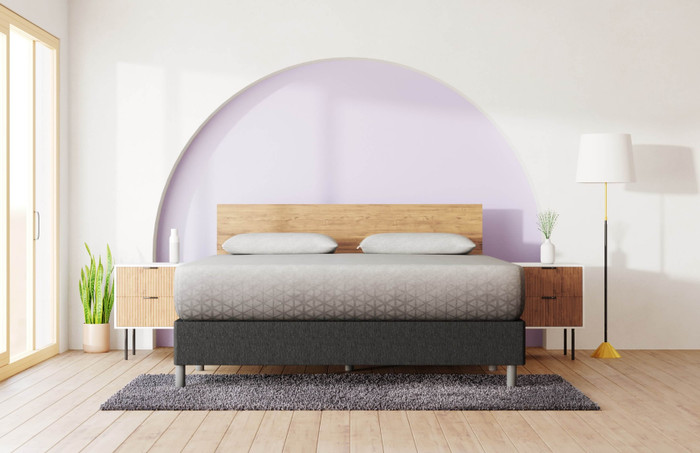What is a Bariartic Bed?

November 4th, 2025 . 9 mins read
Key Takeaways
- What it is: A bariatric bed is a reinforced, wider hospital-style bed (often 42–60″ wide; 500–1,000+ lb capacity) with manual, semi-electric, or fully electric adjustments to support higher weights and complex positioning needs.
- Who it helps: People with obesity, limited mobility/bed-bound conditions, or chronic issues (pressure ulcers, arthritis, edema, sleep apnea, reflux) across hospitals, rehab, long-term care, and home settings—also easing safe transfers for caregivers.
- How to choose (pros/cons): Prioritize weight limit, bed width, height range, mattress type (foam/air/gel), and safety features (rails, locking casters, battery backup). Expect major benefits in comfort, safety, and caregiver workload—balanced against higher cost, larger space needs, heavier/less mobile frames, and reliance on power/controls.
A bariatric bed is a specialized hospital bed designed to support patients who are overweight or obese.
These beds provide extra durability, width, and features to accommodate individuals who require higher weight capacities and greater comfort during medical treatment or recovery.
Who Needs a Bariatric Bed?
Bariatric beds are essential for individuals who require enhanced support and comfort due to specific medical or mobility-related conditions. These specialized beds are designed to accommodate:
- Obesity or Higher-Than-Average Body Weight: Traditional hospital beds may not provide adequate support or safety for individuals with a higher body mass index (BMI), making bariatric beds a crucial alternative.
- Limited Mobility or Bed-Bound Conditions: Patients with difficulty moving independently due to paralysis, neurological disorders, or age-related issues benefit from the sturdy design and adjustable features of bariatric beds.
- Chronic Medical Conditions Requiring Extended Bed Rest: Individuals with conditions such as pressure ulcers, severe arthritis, or cardiovascular diseases need a bed that minimizes discomfort and improves circulation.
- Post-Surgical Recovery for Obese Patients: Those recovering from weight-loss surgery, orthopedic procedures, or other medical interventions may require a bed with specialized positioning and support to aid in healing.
- Conditions Requiring Elevation Adjustments: Patients with sleep apnea, edema, respiratory issues, or acid reflux often need to sleep in an inclined position, which bariatric beds can easily provide.
- Caregivers and Medical Staff Assistance: These beds make it easier for caregivers and medical professionals to assist with patient care, transfers, and repositioning while reducing the risk of strain or injury.
Bariatric beds are commonly used in hospitals, nursing homes, long-term care facilities, rehabilitation centers, and private homes to ensure the safety, comfort, and well-being of individuals requiring specialized support.
Their durable construction, adjustable features, and enhanced weight capacity make them a crucial medical necessity for those in need.
Types of Bariatric Beds
Bariatric beds come in different styles based on patient needs and medical requirements. These beds are specifically designed to provide comfort, support, and safety for individuals with higher weight capacities.
1: Manual Bariatric Beds
Manual bariatric beds require the use of hand cranks to adjust the head, foot, and sometimes the height of the bed. They are the most affordable option but may not be suitable for patients with limited mobility, as adjustments need to be made manually by caregivers.
These beds are commonly found in long-term care facilities where cost savings are prioritized, and staff is available to assist with adjustments.
2: Semi-Electric Bariatric Beds
Semi-electric bariatric beds provide a mix of manual and motorized functions.
The head and foot sections can be adjusted using an electric motor, making it easier for patients to change positions, while the height adjustment still requires a hand crank.
These beds offer a balance between affordability and convenience, making them a popular choice for home care and assisted living settings. They provide added comfort for patients without the higher cost of a fully electric model.
3: Fully Electric Bariatric Beds
Fully electric bariatric beds offer the highest level of convenience, as all adjustments—including height, head, and foot positioning—are controlled with a remote.
These beds are ideal for both home use and hospitals, as they provide ease of care for both patients and caregivers.
The ability to reposition the bed effortlessly helps prevent bedsores, improve circulation, and enhance overall patient comfort. Although they are more expensive, the enhanced functionality and independence they offer justify the investment for many individuals.
4: Low Bariatric Beds
Low bariatric beds are designed to be closer to the ground to minimize the risk of falls. This makes them particularly suitable for patients who frequently roll over in bed or have difficulty getting in and out.
The lower height reduces the risk of injury if a patient does fall, providing peace of mind for caregivers and family members. Some models also come with side rails for additional security. These beds are commonly used in nursing homes and home care settings where fall prevention is a primary concern.
5: Extra-Wide Bariatric Beds
Extra-wide bariatric beds are specifically designed for larger patients who need additional space for comfort and movement. These beds range in width from 42 to 60 inches, providing more room than standard hospital beds.
The added width allows patients to reposition themselves more easily and accommodates those who require extra space for medical treatments. These beds are often found in bariatric units, rehabilitation centers, and specialty care facilities where accommodating larger patients is necessary.
Benefits of Using a Bariatric Bed
1. Enhanced Patient Comfort
Bariatric beds are designed with an extra-wide frame and high-density, pressure-relieving mattresses that distribute weight evenly. This prevents pressure points, reduces the risk of bedsores, and ensures greater comfort for individuals with higher body weight.
Additionally, many models come with customizable firmness levels, allowing patients to adjust the bed to their preferred comfort.
2. Improved Safety
Safety is a top priority in bariatric care, and these beds are built with reinforced frames, heavy-duty materials, and secure side rails to minimize fall risks.
The beds are capable of supporting higher weight capacities, ensuring stability even when patients shift positions. Many models also include emergency controls for caregivers to quickly adjust the bed in case of a medical situation.
3. Ease of Care for Caregivers
Bariatric beds come with electric controls that allow smooth adjustments for height, head elevation, and leg positioning at the touch of a button. This reduces the physical strain on caregivers who would otherwise have to manually reposition patients.
Some beds also include built-in features like tilt functions or turning assistance to facilitate routine care, such as bathing, dressing, and medical procedures.
4. Better Health Outcomes
A well-designed bariatric bed supports the body properly, helping to alleviate common health issues such as joint pain, muscle stiffness, and respiratory difficulties. By reducing pressure on sensitive areas, these beds lower the risk of pressure ulcers and improve circulation.
Adjustable positioning can also aid digestion, reduce acid reflux, and promote better breathing, particularly for patients with sleep apnea or other respiratory conditions.
5. Mobility Assistance
Bariatric beds are equipped with adjustable height settings and positioning options that make it easier for patients to move.
Features like a low-bed setting allow patients to get in and out of bed with minimal effort, while elevated positions help them sit up comfortably for meals or therapy sessions.
Some models also include grab bars or transfer aids that assist in safely transitioning to a wheelchair or walker, promoting greater independence.
Potential Downsides of Bariatric Beds
1. Higher Cost
Bariatric beds are more expensive than standard hospital beds due to their reinforced construction, wider frames, and additional features. The cost can be a concern for individuals or healthcare facilities with budget constraints, and insurance coverage may not always fully cover the expense.
2. Large Size and Space Requirements
These beds are significantly wider and heavier than regular hospital beds, requiring more space in a room. This can be challenging in smaller homes, assisted living facilities, or crowded hospital rooms, making movement around the bed more difficult.
3. Limited Mobility
While bariatric beds assist with patient movement, their size and weight make them difficult to relocate. Moving the bed between rooms or during transport requires additional effort and sometimes specialized equipment.
4. Complexity of Use
Advanced electric controls and adjustable features can be overwhelming for some users, particularly elderly patients or caregivers who are unfamiliar with the technology. Training may be needed to operate the bed properly and maximize its benefits.
5. Power Dependency
Most bariatric beds rely on electric motors for height and position adjustments. In case of a power outage, some functions may become unavailable unless the bed has a battery backup or a manual override system.
6. Limited Aesthetic Appeal
Bariatric beds are designed primarily for functionality, often lacking the aesthetic appeal of traditional bedroom furniture. This may be a concern for home users who prefer a more homely and inviting appearance in their living space.
How to Choose the Right Bariatric Bed?
1. Consider the Weight Capacity
One of the most crucial factors in selecting a bariatric bed is ensuring it has the appropriate weight capacity. Standard hospital beds typically support up to 450 lbs, but bariatric beds start at 500 lbs and can accommodate patients weighing 1,000 lbs or more.
It is essential to factor in not just the patient’s body weight but also any additional weight from bedding, medical equipment, or caregivers assisting with repositioning.
A higher weight capacity enhances durability and prevents mechanical strain, ensuring both safety and longevity. Choosing a bed with an adequate weight limit prevents the risk of structural failure and ensures that the patient remains comfortable and secure at all times.
2. Check the Bed Width
Bariatric beds come in various widths to provide the right balance of comfort and space efficiency. The standard width for a bariatric bed is around 42 inches, offering ample room for most patients while remaining practical for home and hospital use.
For individuals who require more space for movement or repositioning, extra-wide options ranging from 48 to 54 inches are available. These provide additional comfort and flexibility, particularly for patients who tend to shift frequently during sleep or require caregiver assistance.
The widest option, at 60 inches, offers maximum comfort and is suitable for those who need additional room due to body size or medical conditions that require a larger sleeping surface. While a wider bed improves comfort, it is important to ensure that the room can accommodate the size without restricting caregiver mobility or access to essential medical equipment.
3. Assess Ease of Cleaning & Maintenance
Hygiene is crucial for patients with limited mobility, as they may be more prone to infections and skin conditions. Look for a bed frame and mattress with easy-to-clean materials, such as waterproof or antimicrobial covers, which help prevent bacteria buildup and odor retention.
Some models come with removable mattress covers or stain-resistant coatings, making maintenance simpler for caregivers. Ensuring the bed has minimal crevices and smooth surfaces also reduces the effort required for regular cleaning and sanitation.
4. Consider Height Adjustability for Transfers
The ability to raise or lower a bariatric bed is essential for both patient comfort and caregiver convenience. Height-adjustable beds allow easier transfers in and out of wheelchairs, reducing the risk of falls and strain.
A low-height setting can be beneficial for individuals at risk of rolling out of bed, while a higher position makes it easier for caregivers to perform medical procedures or assist with repositioning. Choosing a model with a broad height adjustment range enhances both safety and usability.
5. Choose the Right Mattress Type
Selecting the appropriate mattress is just as important as choosing the bed frame, as it directly impacts patient comfort and health.
Foam mattresses are a popular choice because they provide firm support and help distribute weight evenly, making them ideal for individuals who require stability and pressure relief.
High-density foam can prevent pressure sores and improve spinal alignment, enhancing overall comfort.
Air mattresses are another excellent option, particularly for patients who spend extended periods in bed. These mattresses are designed to redistribute pressure and help prevent the development of pressure ulcers by adjusting air distribution.
Many air mattress models include alternating pressure systems that improve circulation and reduce the risk of bedsores.
Gel mattresses, which contain cooling gel-infused layers, offer additional comfort by regulating body temperature and providing a cooling effect. This type of mattress is particularly beneficial for patients who tend to overheat or experience discomfort due to prolonged bed rest. Choosing the right mattress depends on the patient’s specific medical needs, comfort preferences, and budget considerations.
6. Look for Safety Features
Bariatric beds often come with essential safety features that enhance patient security and caregiver convenience. Side rails are a crucial addition, as they help prevent falls and provide support when repositioning or sitting up. Many beds offer adjustable or removable side rails, allowing flexibility based on the patient’s needs.
Another important feature is locking wheels, which make it easy to move the bed when necessary but provide stability when secured in place, preventing unwanted movement. For electric beds, a battery backup system is essential, ensuring that the bed remains operational in the event of a power outage.
This feature is particularly critical for patients who rely on adjustable positions for comfort and medical care. Prioritizing these safety features not only protects the patient from potential accidents but also makes caregiving tasks easier and more efficient.
7. Consider Space & Room Setup
The size and placement of a bariatric bed should be carefully considered in relation to the room’s layout. Before purchasing, it is important to ensure that the bed fits comfortably in the designated space without obstructing pathways or limiting access to other medical equipment.
There should be sufficient room around the bed for caregivers to assist the patient effectively, allowing easy access for repositioning, dressing, and medical procedures. If the bed is electrically operated, it is also necessary to check whether power outlets are conveniently located for smooth operation.
Additionally, the space should accommodate any necessary medical accessories, such as overbed tables, IV stands, or mobility aids. Proper planning ensures that the patient receives optimal care in a well-organized and accessible environment.
8. Budget & Insurance Coverage
Bariatric beds vary widely in price based on features, with costs typically ranging from $1,500 to $5,000 or more. Factors influencing the price include weight capacity, adjustment mechanisms, safety features, and mattress type.
When considering a purchase, it is important to explore insurance options, as many insurance providers, Medicare, or Medicaid may cover the cost if the bed is deemed medically necessary.
If full coverage is not available, partial reimbursement or rental options might be worth exploring, especially if the bed is only needed for a limited period.
Comparing different models and features can help individuals find the best balance between affordability and functionality. Investing in the right bariatric bed ensures that the patient receives the necessary support and comfort while minimizing financial burden.
FAQs
Can Bariatric Beds Be Customized for Specific Patient Needs?
Yes, many bariatric beds come with customizable features such as adjustable height, specialized mattresses, side rail options, and built-in scales for weight monitoring. Some models also offer advanced positioning options like Trendelenburg and reverse Trendelenburg, which help with circulation and respiratory support.
Do Bariatric Beds Require Special Flooring or Room Modifications?
While most bariatric beds can be placed on standard flooring, heavy-duty models may require reinforced flooring, especially in older buildings. It’s also important to check doorway widths and available space to ensure smooth movement of the bed within the home or healthcare facility.
Are There Portable or Foldable Bariatric Beds?
Some bariatric beds are designed with portability in mind, featuring collapsible frames or modular components for easier transport and storage. These are particularly useful for home care situations where space is limited or for temporary medical needs that require frequent bed relocation.
How Noisy Are Electric Bariatric Beds?
Modern electric bariatric beds are designed with quiet motors to ensure minimal disturbance during adjustments. High-quality models use smooth, low-decibel actuators to enhance comfort and prevent sleep disruption, which is crucial for patients requiring frequent repositioning throughout the night.
Can Bariatric Beds Accommodate Medical Devices?
Yes, bariatric beds can be equipped with attachments for IV poles, oxygen tanks, and other medical devices. Many models also feature built-in power outlets and accessory hooks, making it easier to integrate essential medical equipment without additional modifications.
How Often Should a Bariatric Bed Be Maintained?
Regular maintenance is essential for the longevity and safety of a bariatric bed. It is recommended to inspect the bed’s frame, motors, and electronic components every six months. Hospitals and care facilities often follow manufacturer guidelines for routine servicing, while home users should check for signs of wear and tear to prevent malfunctions.
Conclusion
A bariatric bed is a crucial investment for individuals with higher weight needs and mobility challenges. These beds provide enhanced support, safety, and comfort—whether in hospitals, nursing homes, or home care settings.
When choosing a bariatric bed, consider weight capacity, adjustability, and mattress type to ensure the best care experience.
If you’re looking for a reliable, high-quality bariatric bed, consult a medical equipment provider to find the best option for your needs!
This article is for informational purposes and should not replace advice from your doctor or other medical professional.



